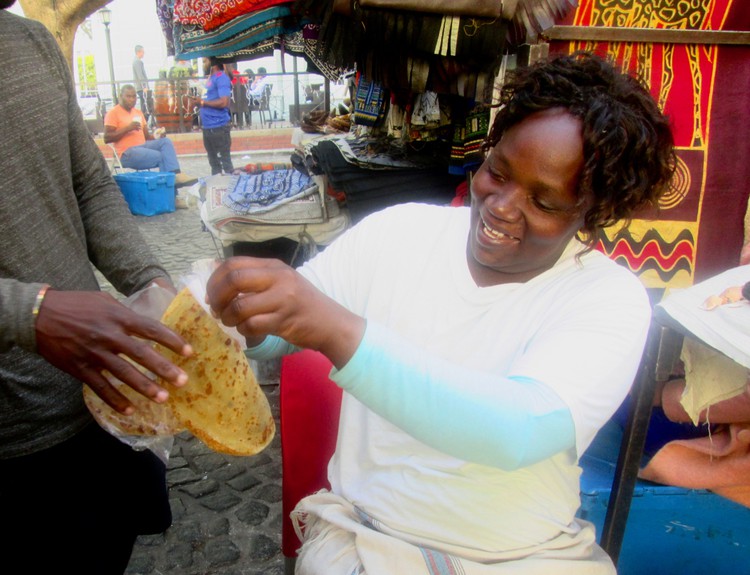Greenmarket Square not what it used to be, say traders
Although almost every available stall space is taken, traders say business has been dropping year after year
“Business is on and off. If you are lucky you may make one or two sales a week. There is no business [here] anymore,” says Lindiswa Zana, who has a stall in Greenmarket Square in central Cape Town. She sells bowls from Bulawayo and a variety of bangles and ornaments.
“We commonly struggle in winter, but for almost two years now seasons don’t matter … We are always struggling to get customers.”
She blames high competition. The moment a product is spotted as selling well, the market is flooded with it. “I have just stopped selling scarves because almost every stall was having the same thing,” she said.
Zana has been trading on the square since 2003. A mother of three, she is not yet prepared to throw in the towel.
Her turnover is R3,000 to R8,000 a month. She pays R49 a day to travel to and from Khayelitsha, R30 a day to two paid helpers who put up her awning, R350 a week for someone to push her trolley from the storage area, R400 a month for storage in Burg Street, and R554 a month to the City of Cape Town for the stall space. That is an overhead of about R4,250 per month. She still has to buy the stock.
A Kenyan woman, who gave her name only as Alice, said she is struggling. She now also sell chapatis to other immigrants in the market to make extra money.
“In the past on a good day I would make about a thousand a day, but these days the highest amount I can make on a good day is about R200. Several times a week I return home without making a single cent,” she said.
To save on storage costs she has to sell items below cost. She points to some big bowls. “I bought them in bulk from people coming from Zimbabwe, but because they have stayed in stock for a long time I am now selling them less than their value.”
A man from Senegal, who gave his name as Abdul, said he had been on the market for ten years and business was decreasing every year.
GroundUp spoke to numerous stall owners and they were all gloomy about business. Only one stall owner, Merlyn from Zimbabwe, said she was doing well. She sells small decorated metal cups, wooden salt shakers, seashells and purses made from recycled cans. She said on a bad day she turns over R500, on a good day R2,500.
For eight years she used to sell at the Pan African Market, but the traders were evicted a few years ago. The rental at Greenmarket Square is lower and she is sharing a stall. But, she says, she lost her regular customers in the move.
City of Cape Town Mayco Member for Urban Management Grant Twigg said Greenmarket Square is a prime trading site and remains a popular space. The stalls are 95% full, at almost total capacity.
“We receive enquiries almost on a daily basis from interested traders. The number of trading stalls has not changed over the past ten years. Over the past years, the product mix has evolved. We continue to advertise and attract other product sellers, to offer diverse products that will respond to the market demand,” he said.
Next: Communicare leadership cleared of corruption allegations
Previous: Eastern Cape immigrant shop owners say they pay for protection from “xenophobia”
Letters
Dear Editor
Thanks for your regularly topical and insightful articles about issues of concern to people at the grass roots, on the ground level. The article about the continuing reduction in interest in and turn-over of stall holders on Greenmarket Square is another of these.
I am sure many share with me the very fond memories of Greenmarket square 30 and 40 years ago when the goods available there were original, fresh, and very often locally produced. In recent years it has become yet another hum-ho with goods which can be found anywhere and little original on offer. No wonder interest has waned, and continues to do so.
Some years ago the city, recognising that the Square was losing its vibrancy, spent a lot of money on redoing the paving when it was difficult to see what was wrong with the existing paving, and there were many complaints about the worse quality of the new surface following the costly re-paving. But this appears to be how authorities most often respond: rather than seek to address the root causes of a problem, it is easy to spend budgets on (often useless) infrastructural development.
Character is created by people and innovation, the infrastructure is merely the canvas enabling the expression of fresh creativity. The success of the Biscuit Mill in Salt River demonstrates this amply where the infrastructure provides an inviting environment in which originality can thrive, bringing crowds of interest.
© 2019 GroundUp.
This article is licensed under a Creative Commons Attribution-NoDerivatives 4.0 International License.
You may republish this article, so long as you credit the authors and GroundUp, and do not change the text. Please include a link back to the original article.



